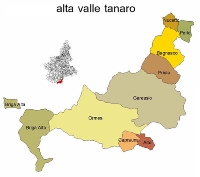The Briga Area

VISITING ROUTE
To reach the Briga area from the Padan plain in proximity of Ceva, follow the state road SS28 along the Tanaro Valley up to Ponte di Nava. Then, follow the provincial road SP154 in the valley of torrent Tanarello and then in that of torrent Negrone. On the left side of the valley one finds Viozene, hamlet of Ormea, at the foot of Mongioie Mountain (2630 m). The village hosts an hotel and some summer houses, being the starting point of the walking path reaching the Mongioie refuge and of several mountaineering and caving routes in the area of the Park of Pesio and Tanaro Valleys (Parco valle Pesio e val Tanaro).
Continuing on the provincial road along the narrow valley, before the Gorge of Fascette turn right to Carnino, hamlet of Briga Alta, composed of Carnino Inferiore (lower) and Superiore (upper) and other scattered houses. The hamlet has been abandoned for decades and at present some houses are under restoration. Several houses still maintain traits of alpine architecture such as wooden balconies and tiled “lose” or thatched roofs. The environment is characterized by wide beech woods. Carnino is the starting point for several walking paths in the park.
Going back to the valley bottom and carrying on along the SP154 it is worth to stop at Gorge of Fascette where the torrent Negrone is captured in a swallow hole and disappears underneath. The 300m depth canyon is usually dried. The torrent water, together with those drained by a larger underground system, springs back at Garb d’la Fus, 500 m downstream.
Leaving the gorge, the provincial road comes to a small valley where on the left side one finds Upega, another hamlet of Briga Alta with nice stony houses where metal roofs replace the original ones formerly made with stone or rye straw. Further on, one finds the chapel of Madonna delle Nevi (13th century) and the Navette wood, an extended larch wood registered in the national list of seed breeding.
On the other side of the Colletta pass one finds the hamlets Le Salse and Valcona Sottana and arrives at Piaggia, the core hamlet of Briga Alta. The village is surrounded up to the mountain crest by steep terraces today almost completely abandoned. In front of the village stands the Saccarello Mountain (2200m) with its bare top and with broad larch woods on its mountainsides.
Lavender, fragrance of Occitania
From the Ligurian Alps overlooking the sea up to the Susa Valley, lavender flourishes spontaneously in dry and stony slopes, preferring limestone soils. In the Tanaro Valley lavender is well diffused on the mountainsides of Mongioie and Marguareis. Colle di Nava is a village in province of Imperia where it is possible to find perfume emporiums well equipped with lavender essential oils and cosmetics. Formerly, in Cuneo valleys harvesting lavender was a profitable activity that was regulated by the municipalities for the mountain land of their competence. Women in particular were dedicated to this activity during the daily pasture at the time when the mountain was fully exploited and not invaded by woods. Picking up the flowers in summer time strengthened the plant and it is possible to imagine a mountain landscape much flowery and fragrant than today.
commenta